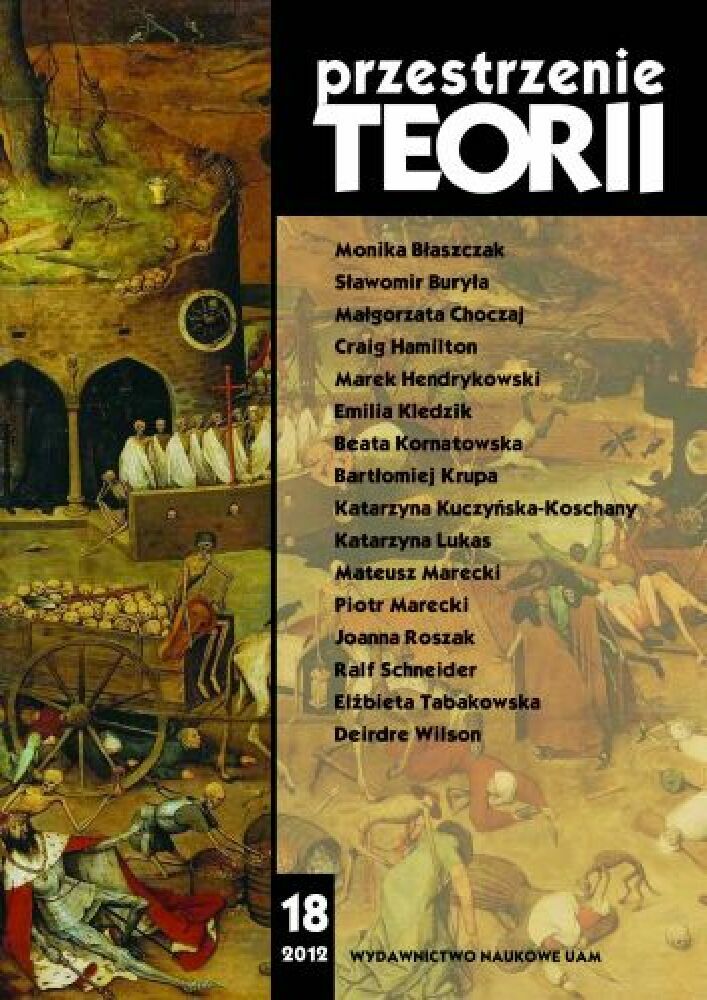Abstrakt
I compare the suicide deaths of Heinrich von Kleist and Jean Améry (Hans Mayer). I discuss the issue of suicide, considering it as a category of the German language and distinguish the difference between the terms ‘Selbstmord’ [self-annihilation] and ‘Freitod’ [self-inflicted death, voluntary death]. By comparing the two suicides committed on the two verges of modernity (the beginning of 19th century in Berlin and 20th century after Auschwitz), I try to describe them as an experience of the imagination (in the words of Stefan Chwin) and as a specific act of creation: a choice of a voluntary death. Suicide, comprehended as a confirmation of our existential freedom, was a deviation from what was considered the norm in Prussia in 1811 and did not seem possible as anything else than an act of despair, when committed by a death camp survivor. However, Heinrich von Kleist and Jean Améry have set a precedent in the existing cultural and historical paradigms of suicide.Bibliografia
E. Cioran, Zły demiurg, przeł. I. Kania, Krakow 1995, s. 47-48.
B. Baran, Przedmowa do wydania polskiego, [w:] J. Amery, O starzeniu się. Bunt i rezygnacja. Podnieść na siebie rękę. Dyskurs o dobrowolnej śmierci, przeł. i przedmową opatrzył B. Baran, Warszawa 2007, s. 10.
M. Głowiński, Czarne sezony, Kraków 2002, s. 35-41
S. Chwin, Samobójstwo jako doświadczenie wyobraźni, Gdańsk [b.d.w.], s.338, 422-423
H. von Kleist, Listy, przekł. i wstęp W. Markowska, Warszawa 1983, s. 520-522,
M. Brion L’Allemagne romantique: Kleist, Brentano, Wackenroder, Tieck, Caroline von Günderode, Paris 1962, s. 13
M. Janion, Absolut, namiętność, tragedia. Posłowie, [w:] H. von Kleist, Dramaty wybrane, przeł. J.S. Buras, Kraków 2000, s. 353
A. Alvarez, Bóg bestia. Studium samobójstwa, przeł. Ł. Sommer, Warszawa 1997, s. 39.
R.M. Rilke, Der Tod, [w:] Gedichte. Zweiter Teil. Sämtliche Werke, hrsg. vom Rilke- Archiv in Verbindung mit Ruth Sieber-Rilke, besorgt durch Ernst Zinn, Frankfurt am Main 1987, s. 103-104.
R.M. Rilke, Śmierć, [w:] Poezje, wybrał, przeł. i posłowiem opatrzył M. Jastrun, Kraków 1993, s. 345.
R. Varnhagen von Ense (19 maja 1771–7 marca 1833, ur. i zm. w Berlinie jako RahelLevin, potem używała nazwiska Rahel
Brockhaus-Enzyklopädie in 30 Bänden. 21., vollig bearbeitete Auflage. Band 28. F.A. Brockhaus, Leipzig–Mannheim 2006, s. 559,
H. Arendt, Rahel Varnhagen: Lebensgeschichte einer deutschen Jüdin aus der Romantik, Munchen 2003.
Rachela von Varnhagen do Aleksandra von der Marwitz. Cyt. za: Listy, przeł. H. Kahanowa, [w:] H. von Kleist, Dzieła wybrane, Warszawa 1960, s. 682-683
J. Amery, Poza winą i karą. Próby przełamania podjęte przez złamanego, przeł. R. Turczyn, posłowiem opatrzył P. Weiser, Kraków 2007, s. 53-54
P. Goldammer, Heinrich von Kleist. Mit 56 Abbildungen. VEB Bibliographisches Institut Leipzig 1980 [Bildbiographie], s. 35-36
A. Kowalczykowa, Samobójcy romantyczni, „Ruch Literacki” 1983, nr 6, s. 434.
M. Cyranowicz, Dlaczego von Kleist? Motyw samobójstwa Heinricha von Kleista w twórczości Marcina Świetlickiego, Jacka Podsiadły, Stefana Chwina i Manueli Gretkowskiej. W zbiorze: Literatura polska. 1990– 2000, red. T. Cieślak, K. Pietrych, t. 1, Kraków 2003, s. 346-365.
Wielka encyklopedia powszechna PWN, t. 15: kreteńska kultura – limitatio, Warszawa 2003, s. 493.
Licencja
Autorzy
Autorzy tekstów przyjętych do publikacji w czasopiśmie „Przestrzeniach Teorii” są zobowiązani do wypełnienia, podpisania i odesłania na adres redakcji umowy o udzielenie nieodpłatnej licencji do utworów, z zobowiązaniem do udzielania sublicencji CC.
Zgodnie z umową, autorzy tekstów opublikowanych w czasopiśmie „Przestrzeniach Teorii” udzielają Uniwersytetowi im. Adama Mickiewicza w Poznaniu niewyłącznej i nieodpłatnej licencji oraz zezwalą na użycie sublicencji Creative Commons Attribution-NonCommercial-NoDerivatives 4.0 International (CC BY-NC-ND 4.0).
Autorzy zachowują prawa do dalszego, swobodnego rozporządzania utworem.
Autorzy, którzy wykorzystują w swoim tekście cudze utwory (np. ilustracje, fotografie) proszeni są o dostarczenie do redakcji czasopisma zgodę na publikację od uprawnionych podmiotów.
Użytkownicy
Zainteresowani użytkownicy internetu uprawnieni są do korzystania z utworów opublikowanych po 2015 roku „Przestrzeniach Teorii” tylko w calach niekomercyjnych, pod następującymi warunkami:
- uznanie autorstwa - obowiązek podania wraz z rozpowszechnionym utworem, informacji, o autorstwie, tytule, źródle (odnośniki do oryginalnego utworu, DOI) oraz samej licencji;
- bez tworzenia utworów zależnych - utwór musi być zachowany w oryginalnej postaci, nie można bez zgody twórcy rozpowszechniać np. tłumaczeń, opracowań.
Do wszystkich tekstów opublikowanych przed 2015 r. prawa autorskie są zastrzeżone.
Inne
Uniwersytet im. Adama Mickiewicza w Poznaniu zachowuje prawo do czasopisma jako całości (układ, forma graficzna, tytuł, projekt okładki, logo itp.).
